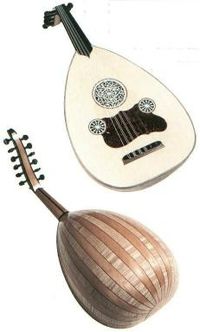- Music of Egypt
-
Life in Egypt 
Culture Cuisine Cinema Music Media Tourism Holidays Healthcare Demography People Languages Religion Human rights Politics Parliament Military Economy Transportation Communications Education Wildlife The music of Egypt has been an integral part of Egyptian culture since ancient times. The ancient Egyptians credited one of their Gods Thoth with the invention of music, which Osiris in turn used as part of his effort to civilize the world. The earliest material and representational evidence of Egyptian musical instruments dates to the Predynastic period, but the evidence is more securely attested in the Old Kingdom when harps, flutes and double clarinets were played.[1] Percussion instruments, lyres and lutes were added to orchestras by the Middle Kingdom. Cymbals[2] frequently accompanied music and dance, much as they still do in Egypt today. Egyptian folk music, including the traditional Sufi dhikr rituals, are the closest contemporary music genre to ancient Egyptian music, having preserved many of its features, rhythms and instruments.[3][4]
They also played recorders and clarinets. In general, modern Egyptian music blends these indigenous traditions with Turkish, Arabic, and Western elements. Arabic music is usually said to have begun in the 7th century in Syria during the Umayyad dynasty. Early Arabic music was influenced by Byzantine, Indian and Persian forms, which were themselves heavily influenced by earlier Greek, Semitic, and ancient Egyptian music. The tonal structure of Arabic music is defined by the maqamat, loosely similar to Western modes, while the rhythm of Arabic music is governed by the awzan (wazn, sing.), formed by combinations of accented and unaccented beats and rests. Typically ancient Egyptian music is composed from the phrygian dominant scale, phrygian scale, Double harmonic scale (Arabic scale) or lydian scale. The phrygian dominant scale may often feature an altered note or two in parts to create tension. For instance the music could typically be in the key of E phrygian dominant using the notes E, F, G sharp, A, B, C, D and then have a A sharp, B, A sharp, G natural and E to create tension.
Since the Nasser era, Egyptian pop music has become increasingly important in Egyptian culture, particularly among the large youth population of Egypt. Egyptian folk music continues to be played during weddings and other traditional festivities. In the last quarter of the 20th century, Egyptian music was a way to communicate social and class issues. Among some of the most popular Egyptian pop singers today are Mohamed Mounir and Amr Diab.
Religious music remains an essential part of traditional Muslim and Coptic celebrations called mulids. Mulids are held in Egypt to celebrate the saint of a particular church. Muslim mulids are related to the Sufi zikr ritual. The Egyptian flute, called the ney, is commonly played at mulids. The liturgical music of the Coptic Church also constitutes an important element of Egyptian music and is said to have preserved many features of ancient Egyptian music.
Music of North Africa  Algeria
Algeria
 Egypt
Egypt
 Libya
Libya
 Mauritania
Mauritania
 Morocco
Morocco
 Sudan
Sudan
 Tunisia
TunisiaContents
Modern popular and folk traditions
 Lute and double pipe players from a painting found in the Theban tomb of Nebamun, a nobleman of the 18th Dynasty of the New Kingdom, c. 1350 BC
Lute and double pipe players from a painting found in the Theban tomb of Nebamun, a nobleman of the 18th Dynasty of the New Kingdom, c. 1350 BC
Contemporary Egyptian music traces its beginnings to the creative work of luminaries such as Abdu-l Hamuli, Almaz and Mahmud Osman, who were all patronized by Khedive Ismail, and who influenced the later work of Sayed Darwish, Umm Kulthum, Mohammed Abdel Wahab, Abdel Halim Hafez, Zakariyya Ahmad and other Egyptian music giants.
Egyptian music began its recorded history in the 1910s, around the time composers such as Sayed Darwish were incorporating western musical forms into their work. Some of the Middle East's biggest musical stars have been Egyptian. Abdel Halim Hafez and Umm Kulthum were especally popular. Most of these stars, including Umm Kulthum, were part of the classical Egyptian and Arabic music tradition. Some, like Abd el-Halim Hafez, were associated with the Egyptian nationalist movement in 1952.
Folk and roots revival
The egyptians even used their own teeth as instruments they would make tapping noises and would use special plucks to make interesting noises with their teeth. The 20th century has seen Cairo become associated with a roots revival. Musicians from across Egypt are keeping folk traditions alive, such as those of rural Egyptians (fellahin), the Nubians, and the Arab and Berber Bedouins. Mixtures of folk and pop have also risen from the Cairo hit factory.
Sawahli (coastal) music is a type of popular music from the northern coast, and is based around the simsimaya, an indigenous stringed instrument. Well-known singers include Abdo'l Iskandrani and Aid el-Gannirni.
Coptic
Coptic music is the liturgical music of the Coptic Church. It consists mainly of chanted hymns in rhythm with instruments such as cymbals (hand and large size) and the triangle. It has preserved the same features of the ancient Egyptian music. Only a handful of its melodies are identified and labeled as Syrian (called Shamy) or Byzantine (called nuga).
Saidi (Upper Egyptian)
Egyptian musicians from Upper Egypt play a form of folk music called saidi (Upper Egyptian). Metqal Qenawi's Les Musiciens du Nil are the most popular saidi group, and were chosen by the government to represent Egyptian folk music abroad. Other performers include Shoukoukou, Ahmad Ismail, Omar Gharzawi, Sohar Magdy and Ahmed Mougahid.
Nubian
Nubians are native to the south of Egypt and northern Sudan, though many live in Cairo and other cities. Nubian folk music can still be heard, but migration and intercultural contact with Egyptian and other musical genres have produced new innovations. Ali Hassan Kuban's efforts had made him a regular on the world music scene, while Mohamed Mounir's social criticism and sophisticated pop have made him a star among Nubians, Egyptians, and other people worldwide. Ahmed Mounib, Mohamed Mounir's mentor, was by far the most notable Nubian singer to hit the Egyptian music scene, singing in both Egyptian Arabic his native Nobiin. Hamza El Din is another popular Nubian artist, well-known on the world music scene and has collaborared with the Kronos Quartet.
Western classical music
Western classical music was introduced to Egypt, and, beginning in the 19th century, instruments such as the piano and violin were gradually adopted by Egyptians. Opera also became increasingly popular during this period, and Giuseppe Verdi's Egyptian-themed Aida was premiered in Cairo on December 24, 1871.
By the early 20th century, the first generation of Egyptian composers, including Yusef Greiss, Abu Bakr Khairat, and Hasan Rashid, began writing for Western instruments. The second generation of Egyptian composers included notable artists such as Gamal Abdelrahim. Representative composers of the third generation are Ahmed El-Saedi and Rageh Daoud. In the early 21st century, even fourth generation composers such as Mohamed Abdelwahab Abdelfattah (of the Cairo Conservatory) have gained international attention.
Revival of ancient Egyptian music
In the early 21st century, interest in the music of the pharaonic period began to grow, inspired by the research of such foreign-born musicologists as Hans Hickmann. By the early 21st century, Egyptian musicians and musicologists led by the musicology professor Khairy El-Malt at Helwan University in Cairo had begun to reconstruct musical instruments of Ancient Egypt, a project that is ongoing.[5][6]
External links
- (French) Audio clips: Traditional music of Egypt. Musée d'Ethnographie de Genève. Accessed November 25, 2010.
- Coptic Orthodox Music of Egypt at Saint Takla Haymanout Church
- Arabic Music and Songs
- Ghostly Echoes: an essay on Egypt and its contemporary music!,
Notes
- ^ Music of Ancient Egypt. Kelsey Museum. University of Michigan, Ann Arbor.
- ^ image
- ^ Hickmann, Hans. "Un Zikr Dans le Mastaba de Debhen, Guîzah (IVème Dynastie)." Journal of the International Folk Music Council. Vol. 9. (1957), pp. 59-62.
- ^ ______. "Rythme, mètre et mesure de la musique instrumentale et vocale des anciens Egyptiens." Acta Musicologica, Vol. 32, Fasc. 1. (Jan. - Mar., 1960), pp. 11-22.
- ^ Pharaonic music
- ^ Ancient Egyptian Music Symposium
Further reading
- Lodge, David and Bill Badley. "Partner of Poetry". 2000. In Broughton, Simon and Ellingham, Mark with McConnachie, James and Duane, Orla (Ed.), World Music, Vol. 1: Africa, Europe and the Middle East, pp 323-331. Rough Guides Ltd, Penguin Books. ISBN 1-85828-636-0
- Music in Egypt: Experiencing Music, Expressing Culture (2007) by Scott L. Marcus, Oxford University Press, New York, ISBN 0-19-514645-X (paper)
Algeria · Egypt · Libya · Mauritania · Morocco · Sudan · Tunisia · Western Sahara
Middle Eastern music By style Al Jeel · Arabesk · Arabic pop · Ashiq music · Bedouin · Classical Arab · Coptic · Iranian folk · Khaliji · Laïka · Mizrahi · Meykhana · Mugham · Ottoman classical · Persian pop · Persian traditional · Qawwali · Samri · Sawt · Sharki · Tsifteteli · Turkish folk
By region Afghanistan · Arabic · Azerbaijani · Bahrain · Cypriot · Djibouti · Egyptian · Eritrea · Iraqi (Assyrian) · Israel · Jordanian · Kurdish · Kuwait · Lebanese · Oman · Palestinian · Persian · Qatar · Saudi Arabian · Somalia · Sudan · Syrian · Turkish · Yemen · United Arab Emirates
Related topics Arabic hip hop · Arabic maqam · Aylugis Gorav · Azerbaijani hip hop · Dabke · Dastgah · Egyptian hip hop · Halay · Iqa' · Iranian hip hop · Israeli hip hop · Kanto · Maqam al-iraqi · Makam · Middle Eastern dance · Middle Eastern hip hop · Muzika Mizrachit · Palestinian hip hop · Pop folk · R'n'Besk · Rapbesk · Tallava · Usul
Music of Africa Sovereign
states- Algeria
- Angola
- Benin
- Botswana
- Burkina Faso
- Burundi
- Cameroon
- Cape Verde
- Central African Republic
- Chad
- Comoros
- Democratic Republic of the Congo
- Republic of the Congo
- Côte d'Ivoire (Ivory Coast)
- Djibouti
- Egypt
- Equatorial Guinea
- Eritrea
- Ethiopia
- Gabon
- The Gambia
- Ghana
- Guinea
- Guinea-Bissau
- Kenya
- Lesotho
- Liberia
- Libya
- Madagascar
- Malawi
- Mali
- Mauritania
- Mauritius
- Morocco
- Mozambique
- Namibia
- Niger
- Nigeria
- Rwanda
- São Tomé and Príncipe
- Senegal
- Seychelles
- Sierra Leone
- Somalia
- South Africa
- South Sudan
- Sudan
- Swaziland
- Tanzania
- Togo
- Tunisia
- Uganda
- Zambia
- Zimbabwe
States with limited
recognition- Sahrawi Arab Democratic Republic
- Somaliland
Dependencies and
other territories- Canary Islands / Ceuta / Melilla / Plazas de soberanía (Spain)
- Madeira (Portugal)
- Mayotte / Réunion (France)
- Saint Helena / Ascension Island / Tristan da Cunha (United Kingdom)
- Western Sahara
Music of Asia Sovereign
states- Afghanistan
- Armenia
- Azerbaijan
- Bahrain
- Bangladesh
- Bhutan
- Brunei
- Burma (Myanmar)
- Cambodia
- People's Republic of China
- Cyprus
- East Timor (Timor-Leste)
- Egypt
- Georgia
- India
- Indonesia
- Iran
- Iraq
- Israel
- Japan
- Jordan
- Kazakhstan
- North Korea
- South Korea
- Kuwait
- Kyrgyzstan
- Laos
- Lebanon
- Malaysia
- Maldives
- Mongolia
- Nepal
- Oman
- Pakistan
- Philippines
- Qatar
- Russia
- Saudi Arabia
- Singapore
- Sri Lanka
- Syria
- Tajikistan
- Thailand
- Turkey
- Turkmenistan
- United Arab Emirates
- Uzbekistan
- Vietnam
- Yemen
States with limited
recognition- Abkhazia
- Nagorno-Karabakh
- Northern Cyprus
- Palestine
- Republic of China (Taiwan)
- South Ossetia
Dependencies and
other territoriesCategories:- Egyptian music
Wikimedia Foundation. 2010.


